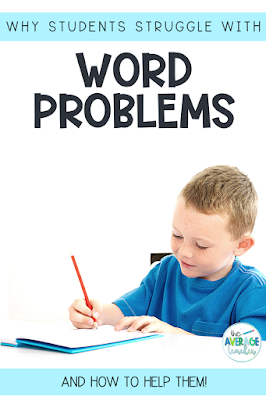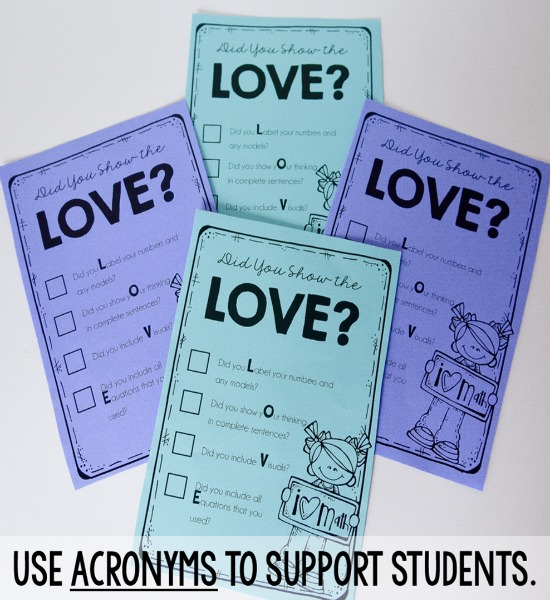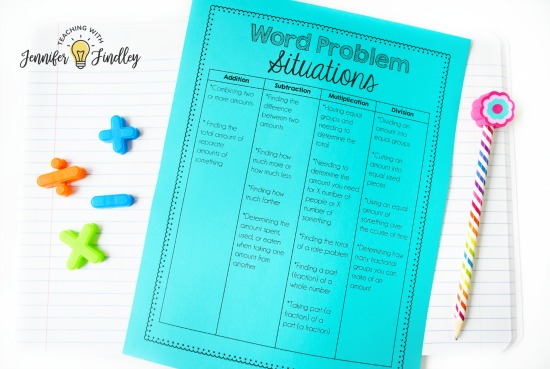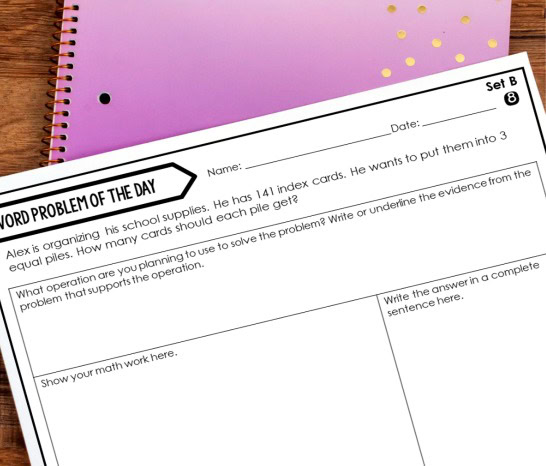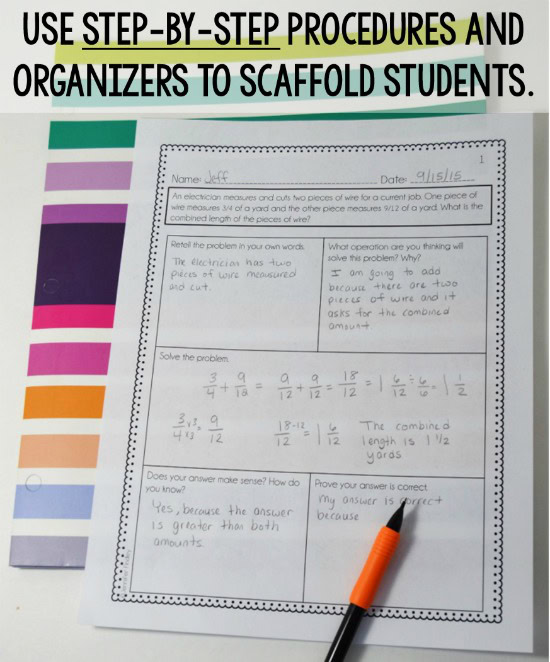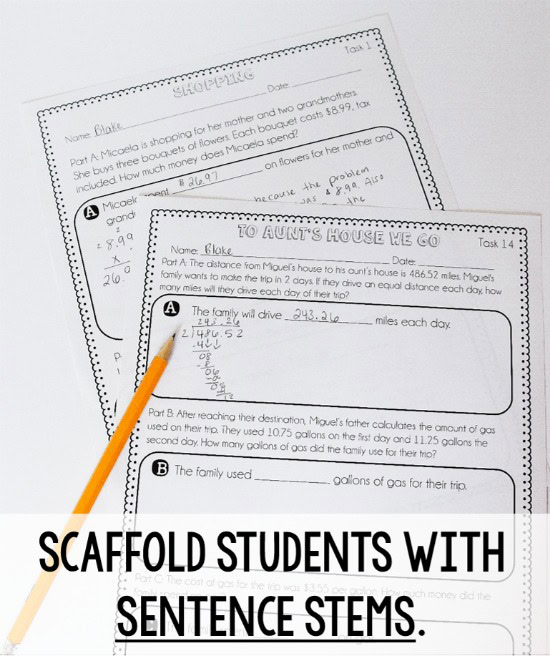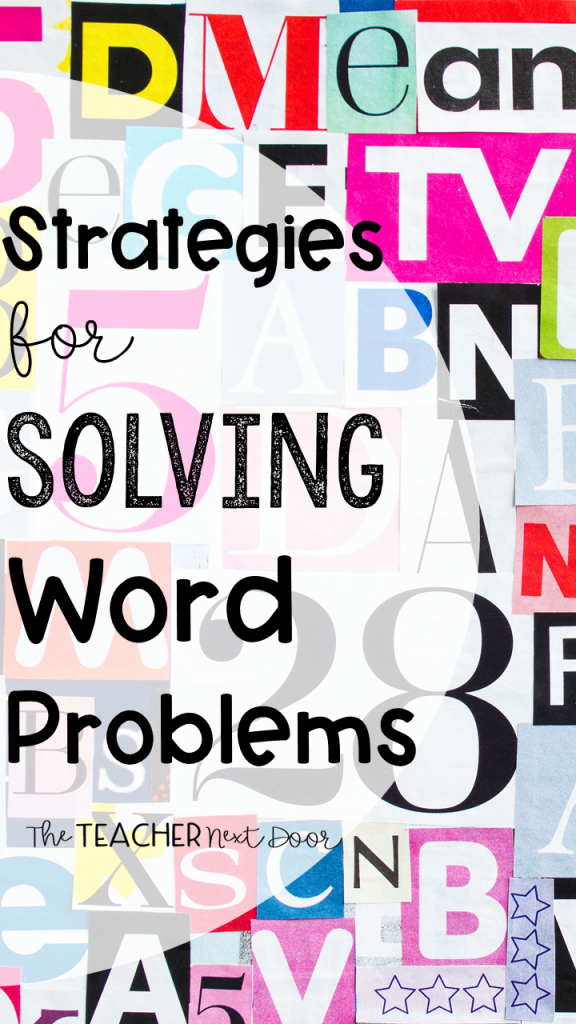
It’s one thing to solve a math equation when all of the numbers are given to you but with word problems, when you start adding reading to the mix, that’s when it gets especially tricky.
The simple addition of those words ramps up the difficulty (and sometimes the math anxiety) by about 100!
How can you help your students become confident word problem solvers? By teaching your students to solve word problems in a step by step, organized way, you will give them the tools they need to solve word problems in a much more effective way.
Here are the seven strategies I use to help students solve word problems.
1. Read the Entire Word Problem
Before students look for keywords and try to figure out what to do, they need to slow down a bit and read the whole word problem once (and even better, twice). This helps kids get the bigger picture to be able to understand it a little better too.
2. Think About the Word Problem
Students need to ask themselves three questions every time they are faced with a word problem. These questions will help them to set up a plan for solving the problem.
Here are the questions:
A. What exactly is the question?
What is the problem asking? Often times, curriculum writers include extra information in the problem for seemingly no good reason, except maybe to train kids to ignore that extraneous information (grrrr!). Students need to be able to stay focused, ignore those extra details, and find out what the real question is in a particular problem.
B. What do I need in order to find the answer?
Students need to narrow it down, even more, to figure out what is needed to solve the problem, whether it’s adding, subtracting, multiplying, dividing, or some combination of those. They’ll need a general idea of which information will be used (or not used) and what they’ll be doing.
This is where key words become very helpful. When students learn to recognize that certain words mean to add (like in all, altogether, combined), while others mean to subtract, multiply, or to divide, it helps them decide how to proceed a little better
Here’s a Key Words Chart I like to use for teaching word problems. The handout could be copied at a smaller size and glued into interactive math notebooks. It could be placed in math folders or in binders under the math section if your students use binders.
One year I made huge math signs (addition, subtraction, multiplication, and divide symbols) and wrote the keywords around the symbols. These served as a permanent reminder of keywords for word problems in the classroom.
If you’d like to download this FREE Key Words handout, click here:
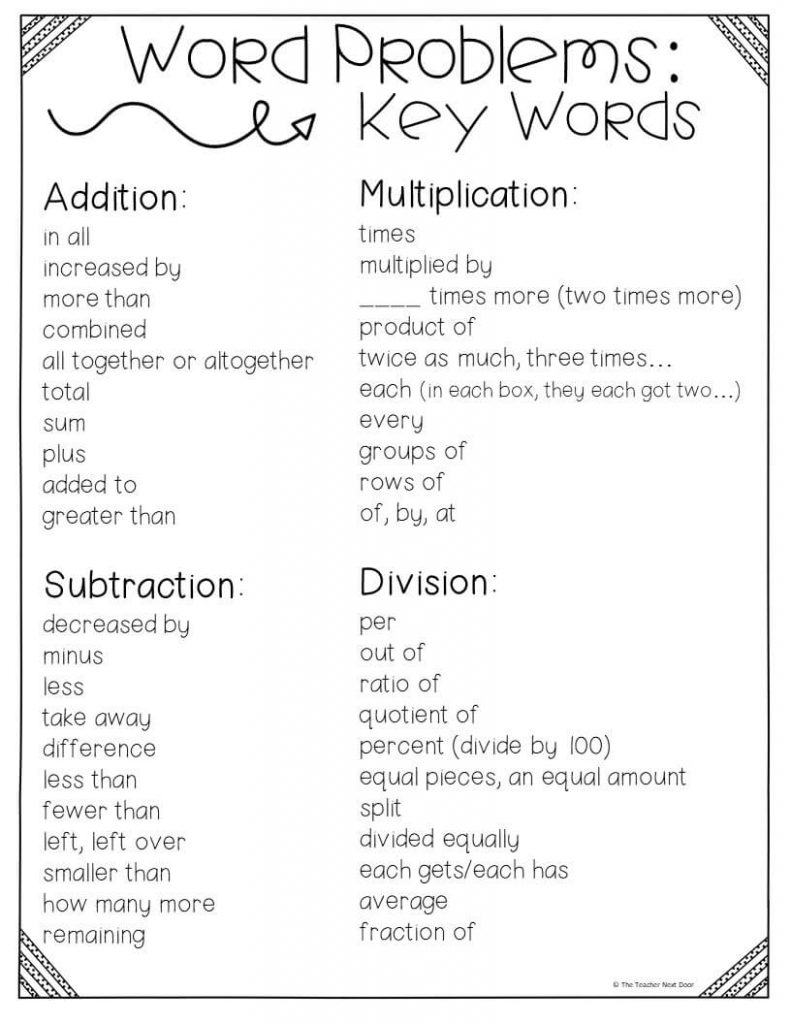
C. What information do I already have?
This is where students will focus in on the numbers which will be used to solve the problem.
3. Write on the Word Problem
This step reinforces the thinking which took place in step number two. Students use a pencil or colored pencils to notate information on worksheets (not books of course, unless they’re consumable). There are lots of ways to do this, but here’s what I like to do:
- Circle any numbers you’ll use.
- Lightly cross out any information you don’t need.
- Underline the phrase or sentence which tells exactly what you’ll need to find.
4. Draw a Simple Picture and Label It
Drawing pictures using simple shapes like squares, circles, and rectangles help students visualize problems. Adding numbers or names as labels help too.
For example, if the word problem says that there were five boxes and each box had 4 apples in it, kids can draw five squares with the number four in each square. Instantly, kids can see the answer so much more easily!
5. Estimate the Answer Before Solving
Having a general idea of a ballpark answer for the problem lets students know if their actual answer is reasonable or not. This quick, rough estimate is a good math habit to get into. It helps students really think about their answer’s accuracy when the problem is finally solved.
6. Check Your Work When Done
This strategy goes along with the fifth strategy. One of the phrases I constantly use during math time is, Is your answer reasonable? I want students to do more than to be number crunchers but to really think about what those numbers mean.
Also, when students get into the habit of checking work, they are more apt to catch careless mistakes, which are often the root of incorrect answers.
7. Practice Word Problems Often
Just like it takes practice to learn to play the clarinet, to dribble a ball in soccer, and to draw realistically, it takes practice to become a master word problem solver.
When students practice word problems, often several things happen. Word problems become less scary (no, really).
They start to notice similarities in types of problems and are able to more quickly understand how to solve them. They will gain confidence even when dealing with new types of word problems, knowing that they have successfully solved many word problems in the past.
If you’re looking for some word problem task cards, I have quite a few of them for 3rd – 5th graders.
This 3rd Grade Math Task Cards Bundle has word problems in almost every one of its 30 task card sets.
There are also specific sets that are dedicated to word problems and two-step word problems too. I love these because there’s a task card set for every standard.
CLICK HERE to take a look at 3rd grade:
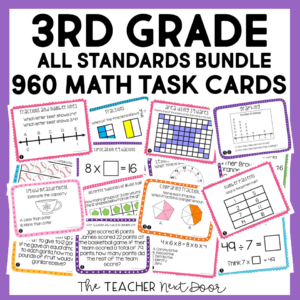
This 4th Grade Math Task Cards Bundle also has lots of word problems in almost every single of its 30 task card sets. These cards are perfect for centers, whole class, and for one on one.
CLICK HERE to see 4th grade:
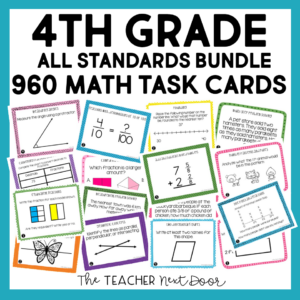
This 5th Grade Math Task Cards Bundle is also loaded with word problems to give your students focused practice.
CLICK HERE to take a look at 5th grade:
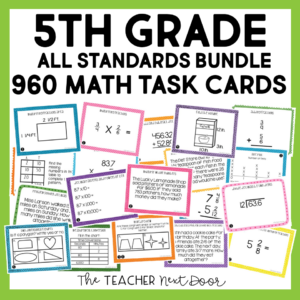
Want to try a FREE set of math task cards to see what you think?
3rd Grade: Rounding Whole Numbers Task Cards
4th Grade: Convert Fractions and Decimals Task Cards
5th Grade: Read, Write, and Compare Decimals Task Cards
Thanks so much for stopping by!

Graph »
Number Line »
Challenge »
Examples »
FAQ »
Correct Answer 
Let’s Try Again 
Try to further simplify
Number Line
Graph
Hide Plot »
Sorry, your browser does not support this application
Examples
-
mathrm{Lauren’s:age:is:half:of:Joe’s:age.:Emma:is:four:years:older:than:Joe.:The:sum:of:Lauren,:Emma,:and:Joe’s:age:is:54.:How:old:is:Joe?}
-
mathrm{Kira:went:for:a:drive:in:her:new:car.:She:drove:for:142.5:miles:at:a:speed:of:57:mph.:For:how:many:hours:did:she:drive?}
-
mathrm{Bob’s:age:is:twice:that:of:Barry’s.:Five:years:ago,:Bob:was:three:times:older:than:Barry.:Find:the:age:of:both.}
-
mathrm{Two:men:who:are:traveling:in:opposite:directions:at:the:rate:of:18:and:22:mph:respectively:started:at:the:same:time:at:the:same:place.:In:how:many:hours:will:they:be:250:apart?}
-
mathrm{If:2:tacos:and:3:drinks:cost:12:and:3:tacos:and:2:drinks:cost:13:how:much:does:a:taco:cost?}
Frequently Asked Questions (FAQ)
-
How do you solve word problems?
- To solve word problems start by reading the problem carefully and understanding what it’s asking. Try underlining or highlighting key information, such as numbers and key words that indicate what operation is needed to perform. Translate the problem into mathematical expressions or equations, and use the information and equations generated to solve for the answer.
-
How do you identify word problems in math?
- Word problems in math can be identified by the use of language that describes a situation or scenario. Word problems often use words and phrases which indicate that performing calculations is needed to find a solution. Additionally, word problems will often include specific information such as numbers, measurements, and units that needed to be used to solve the problem.
-
Is there a calculator that can solve word problems?
- Symbolab is the best calculator for solving a wide range of word problems, including age problems, distance problems, cost problems, investments problems, number problems, and percent problems.
-
What is an age problem?
- An age problem is a type of word problem in math that involves calculating the age of one or more people at a specific point in time. These problems often use phrases such as «x years ago,» «in y years,» or «y years later,» which indicate that the problem is related to time and age.
word-problems-calculator
en
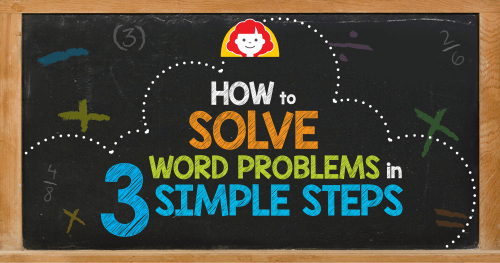
3-Step System
1. Read: Read the problem and decide what the question is asking.
- Read the problem 2 times or more.
- Underline or circle key words, phrases, and numbers. Draw a line through irrelevant information.
2. Plan: Think about what the story is asking you to do. What information are you given, and what do you need to find out?
- Draw a picture.
- Circle or underline key words. (Use highlighters or crayons to color-code key numbers and phrases.)
- Write out the question in your own words.
3. Solve: What strategy could you use to find the missing information: addition, subtraction, multiplication, or division?
- Write a number sentence and solve.
- Use counters.
- Create charts.
Check your work by explaining your reasoning. Does your answer make sense?
Download this free strategy checklist from Math Fundamentals to help your child solve word problems.
Different Strategies to Solve Word Problems
Everyone learns in a different way. What makes sense to one individual often isn’t the easiest option for another. Incorporating different strategies to solve word problems can help your child discover what strategy works best for him or her. A few tips to use are:
1. Circle numbers in a story and underline key phrases.
Color coding is a fun method to incorporate to help children decide what operation the question is asking for. Assign a color to each operation and highlight the phrase that identifies it. For example, red links to addition and blue links to subtraction.
2. Incorporate a key word list.
Key word lists are best used for teaching younger children how to solve word problems. As math curriculum advances, children should not be dependent on a key word list to solve a problem. The questions get trickier.
Addition
In all
Together
Total
Altogether
Combine
Sum
Join
Subtraction
Difference
Fewer
How many more
How much more
Left
Remain
Less
3. Visuals
If your child is a visual learner, drawing a picture or using counters can help him or her understand what the problem is asking. Use number lines, charts, or counters or draw a picture.
4. Write your own word problem.
Knowing what is needed to write a word problem is the first step in identifying key words to solve a story. Take turns writing your own word problems with your child and exchange them to solve.
5. Stay organized.
It is important to write clearly and keep work space neat so children can read and follow their own computations. Many children need a separate piece of paper to allow them enough space to solve and understand their answer. Graphing paper is a great option to help students record neat work.
Download this free sample word problem from Math Fundamentals, grade 1.
How to solve a two-step word problem
In a two-step word problem children are being asking to solve two related equations. These can get tricky for children to understand when they transition from one-step to two-step problems. Help your child understand his or her relationships within two-step word problems with these strategies:
1. Circle important information.
Circle numbers and important phrases that ask questions. The number sentences needed to solve these equations are hidden in those asking questions. Identify the first and second questions needed to solve.
2. Distinguish the two parts of the problem.
First identify the first step of the first part of the word problem. Write a number sentence and solve.
3. Use the answer from the first-step solution to the whole problem.
Use the answer from the first question to help you solve the next equation. What operation does the second question require?
Check your work by explaining your reasoning. What was the question answered? Is the answer reasonable for the question being asked?
Download this free sample two-strategy word problem from Math Fundamentals, grade 2
Download this free sample multi-strategy word problem from Math Fundamentals, grade 4
Evan-Moor’s Math Fundamentals is a great resource for training students how to solve word problems in 3 simple steps. It provides step-by-step directions for solving questions and guides children with helpful visuals and key phrases.
Check out Daily Word Problems for consistent practice solving word problems.
For more fun math tips and strategies check out our Math- Ideas, Activities and Lessons Pinterest Board.
Save these tips and Pin It now!

Word problems are hard. Even I occasionally find myself stumped with figuring out how to correctly solve a word problem — so imagine how our students must feel sometimes!
There are many factors that contribute to why students often struggle with word problems. Fortunately, no student is a lost cause when it comes to this challenging skill. By recognizing why our students might be struggling, we can come up with a strategy to best help them.
Here are some of the common reasons why students have a hard time with word problems, and what you can do to help.
Problem #1: Reading Comprehension
One of the biggest reasons why some students struggle with word problems is because they aren’t just regular math problems — they involve reading! And more than that, students have to be able to fully comprehend what is happening in the problem in order to figure out how to solve it. Therefore, a lack of reading comprehension can play a huge part in a student’s ability to solve word problems.
How to Help
If you notice a student is struggling with word problems because of their reading comprehension, then focus on helping them to better understand what’s happening in the problem. The best way to do this will vary from student to student, but here are a few suggestions:
- Have the student draw a picture of what’s happening as they read it
- Use pictures or other visuals
- Act out the word problem
- Ask lots of questions while reading the problem to keep students focused
- Change the word problem to be more relevant to the student
Problem #2: Only Looking at the Numbers
One super common issue that all elementary math teachers have run into is that students often don’t actually stop to read the problem, but instead pull out the numbers and use a random operation. Unfortunately, this problem often occurs because of the way math textbooks are often designed. The word problems in a particular lesson, of course, have to do with that lesson. If I’m teaching a lesson on subtraction, students can assume that the word problems that follow are going to involve subtraction. This has unintentionally trained our students that they don’t need to actually read the problem — they just need to know the numbers. Of course, this presents an issue on tests that cover a variety of concepts.
How to Help
Two things can be done to help in this situation. First, students need to be in the habit of solving a variety of different types of word problems daily. We need to expose them to word problems regularly, but not that all use the same operation to solve. If your curriculum doesn’t already do this, add in a few practice problems each day to help diversify the types of problems your students are being exposed to.
Another thing you can do is use numberless word problems. That is, remove the numbers from the problems so students are first forced to pay attention to what’s happening. Discuss the problem without the numbers; then, when students are ready, add the numbers back in. This will help get students into the habit of reading the problem.
Problem #3: Tricky Language
One big problem I’ve found with word problems is that many curriculum and exam writers use tricky language, designed to trip students up. I have mixed feelings about this tactic; however the reality is, that’s the way it is! So, even if your students have great reading comprehension and fully understand how to solve a problem, they may still get misled by the wording of the problem and solve incorrectly.
How to Help
Unfortunately, there isn’t a whole lot you can do about the way problems are worded. However, there are still ways that you can help your students to not get tripped up. First, do NOT teach students that certain words indicate any specific operation. This is a practice that used to be commonly used, but textbook companies have caught on and now use that against us. If students have been taught that in the past, you may have some unteaching to do.
The language used is still important to pay attention to, we just don’t want students thinking that certain words ALWAYS mean something (such as «more» ALWAYS means addition. Sometimes, yes, but not always).
Teaching students to use the language instead to help them determine whether the numbers in the problem are a part or the whole is much more effective. For more information on this strategy, check out this post.
Word problems can be tricky, and if you have questions about the best practices to teach them effectively, I have a FREE video series going on right now you might be interested in! Click here to sign up for the free training now.
Comment below if you have any questions or tips for teaching word problems! I’d love to hear from you!
by Kayla @ The Average Teacher
Word problems can be really difficult for upper elementary students. The complexity of the word problems increase, the length of the problems themselves increase, the numbers are larger and more abstract, and often key words just don’t work.
Today I want to share with you eight ways to help students who struggle with word problems in upper elementary grades.
1. Carefully choose or create an acronym to scaffold or support students.
My first tip is to choose an acronym that will either help your students understand and think through a math problem or choose an acronym that helps ensure their work and answer is clear and complete. I personally prefer to use an acronym that both helps the students think through a problem and adequately show all of their work and organize their thoughts.
With this in mind, I created the word problem acronym LOVE about four years ago and have been using it every sense. LOVE helps the students organize their work, their thoughts, while helping ensure the students provide enough to support their answer. The steps embedded in the process also help the students make sense of the word problem as they are forced to use models, labels, etc.
—> Read more about using LOVE to support your students with word problems and grab several freebies by clicking here.
Grab the bookmarks shown in the picture above by clicking HERE.
2. Teach students situations (and not key words) to help them solve word problems.
This was a game-changer for my students. About five years, I stopped teaching key words and moved to teaching situations. We look at common situations and which operation is used in those situations. I even provide a chart for my students to refer to and add to as needed.
When my students are solving a word problem, they refer to the situation chart to help them determine which operation is needed. This helps build their conceptual understand of math operations and helps them master word problems. Read more about how I teach my students to solve word problems without relying on key words (and grab the below poster and a few practice problems that I use) by clicking here.
3. When introducing a new math concept, introduce it through a story or word problem.
When I introduce a new math concept, I always introduce it through the context of a story problem or situation. This helps the students conceptualize the math, see the real-world connection, and to better be able to think through the new math.
—> Read about how I do this to introduce partial quotients division by clicking here.
4. Provide regular exposure to a wide variety of word problems and lots of opportunities to practice.
I will admit that one mistake I made as a first year teacher was teaching computation skills for the first part of the year and then cramming word problems in before our state assessment. I failed to regularly embed them in our regular practice and homework. Now, I have created a ton of word problems in many engaging and purposeful formats so this never happens again. My students love our interactive notebook word problems and I love the word problem of the day routine that we do each day.
Click here to read more about word problem of the day and grab FREE starter packs for 4th and 5th grade word problems.
5. Connect word problems to your students’ lives and experiences whenever possible.
When I write word problems for my own classroom, I always use my students’ names and locations and experiences which which they are familiar. This helps for a few reasons:
- They are immediately engaged in the word problem when they see a familiar name, location, or experience.
- The chances of them remembering the situation (to apply it to new situations) are higher.
- It will be easier for you to refer back to previous word problems to help scaffold students when they encounter new or more difficult word problems.
Tip: I use my already created word problems (or purchased word problems) and just change the names or locations when I write them on anchor charts.
6. Create or use silly word problems.
This is very similar to my strategy from above. In addition to using familiar names and experiences, I love using silly word problems with my students. I have used cartoon characters or word problems that are just silly- think zombies and other science fiction topics.
Here is an example of some themed zombie (nothing scary or assuming they are real) word problems that we used to review multiplication and division. Click here to grab this FREE zombie-themed word problem choice board.
7. Provide opportunities in the classroom for regular sharing and discussion of word problems and strategies to solve them.
We do whole class word problems or math tasks on a regular basis in my classroom. Sometimes we solve them together as a class. More often, the students solve the word problems independently and then we share and discuss strategies used. Once a week, I try set aside 15-20 minutes specifically for sharing ideas and strategies on a given word problem. Read more about how I do this by clicking here.
8. Provide necessary support and scaffolds as needed to help your students succeed.
Sometimes we need to offer a more support for our students solving word problems. There a few ways that I do this in my classroom.
1. Step-by-Step Organizers – I use word problems that have a step-by-step organizer to help the students think through the problem and organize their work. The picture below shows an example of this using my 5th Grade Intervention Word Problems (click here for 4th grade).
Click here for FREE word problem step-by-step organizers that work with any word problem.
2. Sentence Stems – I also help support my students by providing sentence stems for them to use when writing the answer to a word problem (and justify their answer- read more here). I have found that restating the question for the students helps them understand what is being asked. The picture below is an example of how I do this using my 5th Grade Differentiated Multi-Part Math Word Problems.
Hopefully those strategies and tips will give you some ideas to help you tackle word problems with your upper elementary students. Do you have any other strategies you use to help your students?






